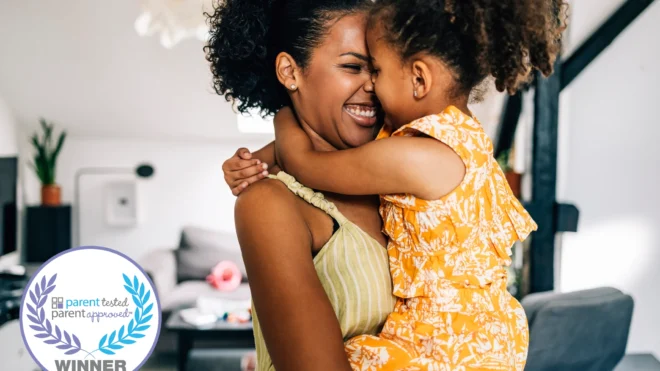
You may have heard that babies and children learn through play — and it’s true! Play is essential for childhood development. According to Johns Hopkins Medicine, play boosts cognition, improves language skills, promotes physical development (fine and gross motor skills), builds emotional intelligence, and helps with social skills.
But how exactly do you play with a newborn baby? There’s a lot of pressure on new parents to provide all sorts of stimulation for babies. There are play boxes for newborns with toys, mirrors, high contrast books and cards, lovey blankets, tummy time activities, and more. There are social media posts all about keeping your newborn baby engaged and occupied with products.
More from Mom.com: Best Ways to Interact With Your Baby During Their First Month
The truth is that newborns don’t need all of that! When your baby is just a few days or weeks old, they have very short wake windows, typically only staying up long enough for a diaper change, a feed, and maybe a few minutes of cuddling. “Playing” looks a lot different for newborns than it does for older infants. While the toys and products are nice, all they really need to play is, well, you!
Here are some of the best ways to “play” with your newborn baby:
Do Some Tummy Time

Parents of newborns are told over and over again how important tummy time is. According to the National Institute of Child Health and Human Development, there are numerous benefits of tummy time, including strengthening baby’s neck, shoulders, and arms, improving baby’s motor skills, and preventing flat spots on baby’s head. Newborns can start tummy time when they’re just a few days old — they should start with a few short sessions each day (3 to 5 minutes, 2 to 3 times each day). As they get older, the sessions can get longer.
Unfortunately, many babies don’t enjoy tummy time… in fact, a lot of them downright hate it. Here are a few tips for making tummy time more enjoyable:
- Do tummy time sessions when baby is in a good mood (like right after a nap or diaper change)
- Place a rolled up towel under baby’s chest/arms to help prop them up
- Lay down in front of baby so they can see your face close up while they’re on their tummy
- Dress baby in as little clothing as possible (just a diaper or onesie is great) so they can feel the textures of the surfaces around them
- Try tummy-to-tummy time, where baby lays on your stomach looking up at you (this can also provide great skin-to-skin time)
- Position baby on your lap lengthwise for tummy time
- Try side-lying as an alternative, placing baby on their side with arms and legs in front of them
Look in the Mirror

Newborns’ favorite things to look at are faces — specifically the faces of their parents. To give baby another interesting face to look at, bring them to a mirror. Newborn babies can’t see very far away (estimates say they can see about 6 to 15 inches at birth), so you may have to get close to the mirror, but this activity can continue through infancy. As they get older, babies can start to track movement with their eyes, identify familiar faces, build hand-eye coordination, and begin to develop a sense of self.
Sing and Dance

Singing and dancing are two things babies absolutely love. Newborns find the sound of their parents’ voices very comforting, so talking and singing is a great way to entertain them. When it comes to dancing, there’s a reason babies find movement, like rocking and bouncing, soothing; it simulates being in the womb. You can hold your baby while you sing and dance, or use a baby wrap/carrier to go hands-free.
Narrate Yourself

Babies find their parents’ voices comforting, so a good way to “play” with them is to talk to them. If you’re not sure what to talk to your baby about, try narrating your day. Tell your baby about the dishes you’re washing, explain the meal you’re making, show them the laundry you’re folding, or just read your own book aloud.
Face to Face Time

Playing with young babies should center on interacting with them — especially having a lot of face time. Since newborns can’t see very far away, make sure to get close to them. Make fun faces, exaggerate your expressions, and be sure to smile and laugh. Babies start to recognize faces quickly, and they learn a lot from facial expressions and movements.
Stretch and Massage

Newborns can’t physically play when they’re young, but you can help them connect with their body through stretching and massage. Move their limbs around, stretching their arms up and around, pedaling their legs, and more. Gentle massage can also be beneficial for newborns; according to the American Academy of Pediatrics, baby massage can help infants feel safe, secure, and loved, and it can help calm them when they’re fussy. Touch is so important for bonding with and comforting a baby, so stretch and massage are great ways to “play.”



